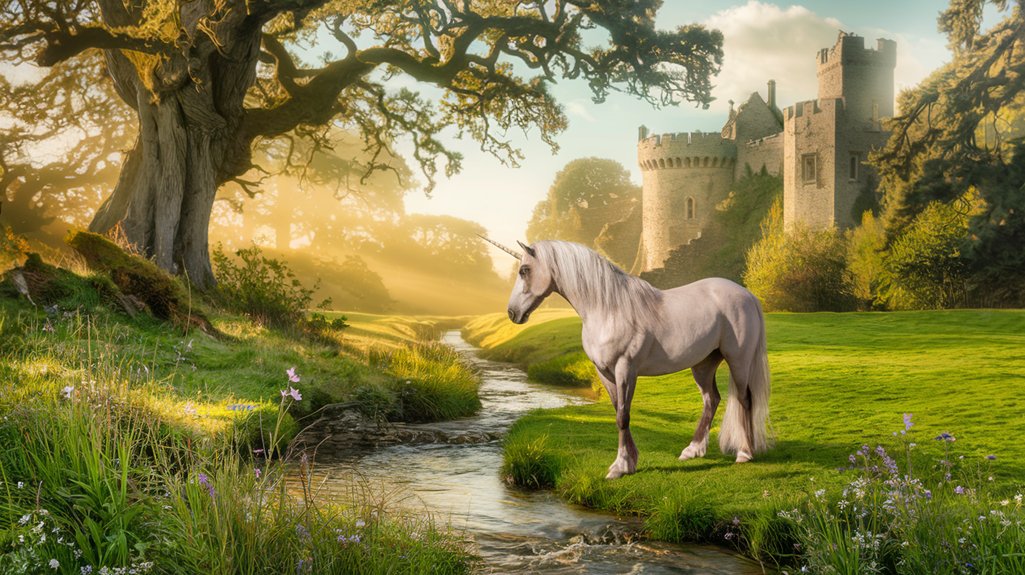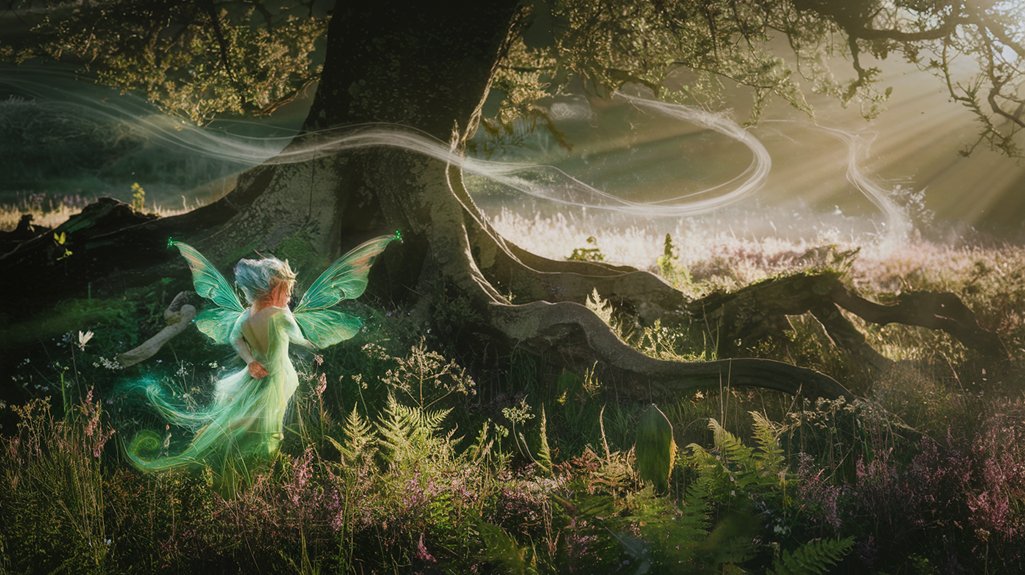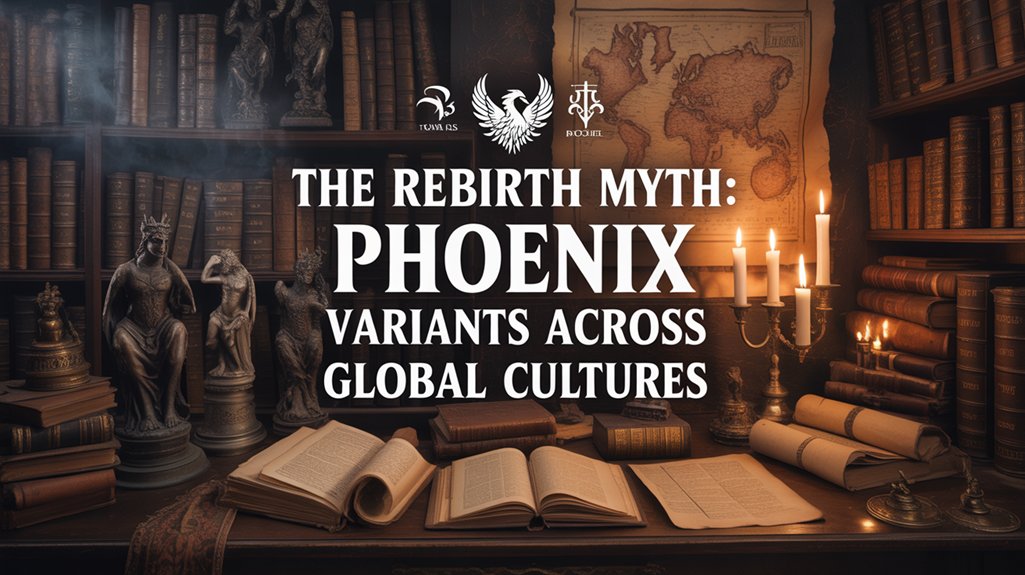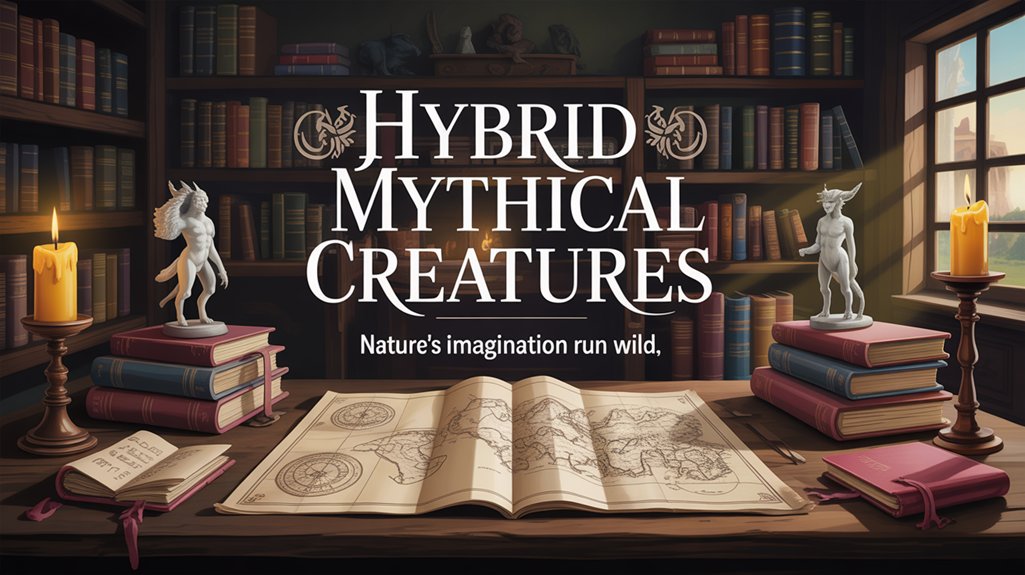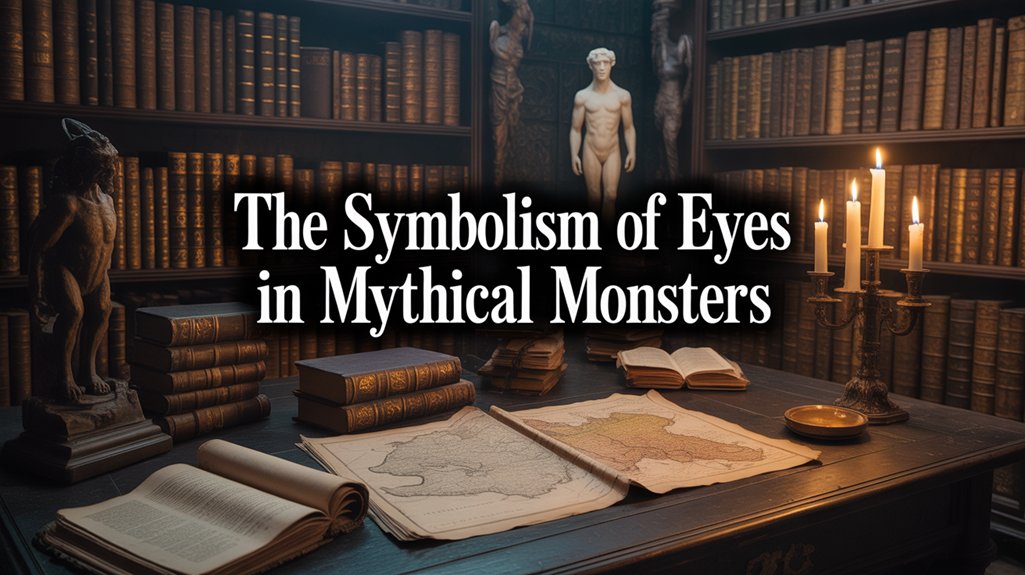
You’ll encounter forest guardians across every culture: the Slavic Leshy commanding wolves through primordial woodlands, Greek Hamadryads bound fatally to individual oaks, Japanese Kodama manifesting as luminous orbs in ancient groves, and Celtic elementals haunting Faerie rings with sovereign authority. These entities emerged independently—eighth century BCE for Dryads, millennia earlier for Algonquian *manitou*—representing humanity’s attempt to negotiate with forests’ fundamentally alien consciousness through offerings of tobacco, bread, salt, and whispered acknowledgments. The patterns reveal sophisticated ecological philosophies treating sylvan domains as territories demanding reciprocity, respect, and recognition that disorientation breeds vulnerability where nature reclaims dominion from human order.
Table of Contents
Toggle🔮 Enhance Your Practice With These Essentials
Chosen for ritual alignment and energetic correspondence.
Key Takeaways
- The Leshy is a Slavic forest master who shape-shifts, commands animals, and grants safe passage to travelers offering bread and salt.
- Dryads are Greek tree spirits bound to specific trees; when their tree dies, the dryad perishes with it.
- Forest guardians across cultures enforce reciprocity, requiring offerings and rituals to maintain harmony between humans and nature’s power.
- These spirits symbolize forests as sovereign entities with ancient laws, serving as mediators between civilization and wilderness.
- Modern media revives these ancient archetypes, reflecting environmental consciousness and warnings about ecological balance in contemporary narratives.
The Leshy: Slavic Master of the Wilderness

Deep within the primordial forests of pre-Christian Slavic lands, where birch and pine formed cathedral-like canopies over moss-carpeted earth, the Leshy reigned as an eldritch sovereign of the wilderness—neither wholly benevolent nor entirely malevolent, but utterly untamed.
🎯 Recommended Products
Handpicked items related to this article:
As an Amazon Associate, we earn from qualifying purchases.
You’ll find this chimeric entity shape-shifting between human and beast, towering above the treetops or shrinking to grass-blade height, his bark-textured skin and twig-tangled beard marking him as forest incarnate.
Leshy folklore warns you against whistling in his territory, for he commands wolves, bears, and the very paths beneath your feet, leading travelers astray who disrespect his dominion.
Yet those who offered bread and salt, who acknowledged his sovereignty, gained safe passage.
Leshy symbolism embodies nature’s essential ambiguity—simultaneously protective and destructive, guardian and adversary.
He doesn’t serve humanity’s interests; you must negotiate with him, recognizing that true wilderness answers to no master but itself.
Freedom demands this understanding.
Dryads: Greece’s Tree-Dwelling Protectors
You’ll find the dryads emerging from Greece’s archaic consciousness around the eighth century BCE, their essence inextricably bound to the xylem and phloem of specific trees—most significantly the oak, though also the ash, the poplar, and the laurel.
These nymphs weren’t merely forest dwellers but symbiotic entities whose pneuma merged with their arboreal hosts, their fates so thoroughly intertwined that a tree’s death meant the dryad’s extinction.
The Homeric hymns and Hesiod’s fragmentary verses preserve this sacred covenant, revealing how ancient Hellenes understood these spirits as mediators between the chthonic sphere and the verdant world above, their presence marking certain groves as temenos—consecrated ground where mortals approached with reverence and fear.
Origins in Greek Mythology
When the ancient Greeks gazed upon their primordial forests—those shadowed groves where sunlight fractured into golden shards through canopies of oak and ash—they recognized presences within the wood itself, entities born not from divine decree but from the very essence of living trees. You’ll find dryads emerging from this sacred nature symbolism, their existence predating Olympian hierarchies.
| Dryad Classification | Tree Association |
|---|---|
| Hamadryads | Oak trees—bound to death |
| Meliae | Ash trees—born from Uranus’s blood |
| Daphnaeae | Laurel groves—Apollo’s domain |
These weren’t mere Greek deities but something more eldritch: souls intertwined with bark and root. Their mortality mirrored their host trees’. When axes bit deep, dryads perished. Freedom meant preservation—their survival, humanity’s covenant with wilderness. Within the broader tapestry of Greek Mythology, these tree spirits existed alongside the pantheon of gods and goddesses like Zeus, Poseidon, and Athena, forming part of the ancient religious stories that explained the natural world.
Bonds With Sacred Trees
Tree communication transcended human linguistic frameworks.
The nymph’s consciousness permeated through root systems, translating mineral uptake into eldritch awareness, photosynthesis into thought.
Wound the oak, you’d wound its guardian. Death was mutual.
This wasn’t chimeric fantasy but recognized reality in pre-Christian Greece, where cutting certain trees meant execution—legal protection acknowledging what you instinctively understand: some bonds defy rational boundaries.
Ancient Greek literature preserved these beliefs through the works of classical poets, documenting the sacred bond between dryads and their trees across countless mythological accounts.
Germanic Woodland Spirits and the Wild Hunt

Across the shadowed canopies of ancient Germania—where oak, ash, and thorn stood sentinel over territories the Romans dared not fully claim—there dwelt spirits whose very existence blurred the boundaries between woodland divinity and ancestral reverie. Germanic folklore preserved these eldritch guardians through oral transmission spanning centuries, entities who rode the storm-winds during winter solstice. The wild hunt thundered through skeletal branches, led by Wodan himself, accompanied by spectral huntsmen and chimeric beasts whose hoofbeats shook reality’s foundations.
| Spirit Type | Domain | Manifestation Period |
|---|---|---|
| Waldgeister | Deep forest groves | Year-round, twilight hours |
| Wild Hunt riders | Storm paths, ancient roads | Winter solstice (Yule) |
| Holzfräulein | Sacred clearings | Spring equinox through harvest |
You’ll find these woodland entities demanded respect, not worship—offerings of bread and mead left at crossroads, whispered acknowledgments before felling timber. Freedom-seekers recognized them as primordial forces rejecting civilization’s encroachment.
Celtic Forest Guardians: From Faeries to Green Men
Where Germanic forests harbored spirits of storm and sovereignty, Celtic woodlands pulsed with an altogether different presence—one less concerned with martial conquest than with the breathing, bleeding boundary between mortal domain and Otherworld.
You’ll find Celtic folklore thick with warnings about Faerie rings, those eldritch circles where elementals gathered, dancing between dusk and dawn. The Green Man emerges from bark and leaf, his chimeric face sprouting vegetation from every orifice—guardian and embodiment simultaneously.
Sacred groves served as temples where Druidic practices unfolded beneath oak canopies, forest rituals acknowledging nature myths too ancient for Roman chroniclers to fully comprehend.
These weren’t gentle woodland sprites but elemental spirits demanding respect, capable of bestowing madness or enlightenment with equal indifference.
The Celtic tradition recognized what civilization often forgets: forests aren’t resources awaiting harvest but sovereign territories where older laws prevail.
Cross uninvited, ignore protocol, disrespect boundaries. The consequences unfold across generations.
Asian Nature Spirits: Kodama, Yakshi, and Forest Deities

How do forests speak when language predates written characters, when the rustle of bamboo or the whisper through cryptomeria branches carries messages older than empire?
You’ll find answers in Kodama legends, where tree spirits manifest as luminous orbs haunting ancient groves, their ethereal presence marking sacred boundaries between mortal and eldritch domains.
Yakshi symbolism pervades Indian traditions—these chimeric female deities entwine themselves around sal trees and ashoka blossoms, embodying fertility’s dangerous abundance.
Forest deity rituals across Asia demand recognition of hierarchies you can’t dismiss as mere superstition. Nature spirit roles function as ecological contracts: respect the cryptomeria, receive protection; wound the banyan, face retribution.
From Japan’s kami-inhabited woodlands to Thailand’s nang mai guardians, these entities enforce reciprocity. They’re not metaphors for conservation. They’re autonomous powers demanding your acknowledgment, your offerings, your understanding that forests possessed sovereignty before humanity invented borders.
Indigenous American Forest Beings and Sacred Groves
Across the vast woodlands of Indigenous North America, you’ll encounter spirit presences that predate colonial cartography by millennia—the Algonquian Manitou, those numinous forces inhabiting ancient groves with an eldritch energy that defies Western categorical thinking.
The Cherokee understood certain forest sites as wahi, sacred spaces where the membrane between physical and spiritual domains grew gossamer-thin, requiring ritual purification before entry.
These weren’t mere superstitions but sophisticated ecological philosophies, acknowledging that consciousness pervades the sylvan world in forms both terrible and beneficent.
Algonquian Manitou Spirit Protectors
Among the Algonquian-speaking peoples who inhabited the vast forests stretching from the Atlantic seaboard to the Great Lakes, the concept of *manitou*—variously translated as spirit, mystery, or sacred power—permeated every birch tree, every moss-covered stone, every shadow-dappled clearing where sunlight fractured through the canopy.
You’ll discover that Algonquian beliefs recognized *manitou* manifestations as both benevolent guardians and eldritch forces demanding respect through tobacco offerings and careful protocol. These weren’t anthropomorphic deities but chimeric presences dwelling in ancient groves, shape-shifting between animal and elemental forms.
The *kitchi-manitou* governed lesser spirits who protected specific territories—each beaver pond, each stand of white pine held its own sacred consciousness. Understanding these protectors means acknowledging sovereignty over land you traverse, recognizing that freedom coexists with reverence for powers predating colonial borders.
Cherokee Sacred Forest Sites
When Cherokee ancestors gazed upon the forested peaks of the southern Appalachians—*Shaconage*, the place of blue smoke—they perceived a landscape saturated with spiritual potency, where particular sites functioned as thresholds between the ordinary world and the domain of the *nunnehi*, the immortal people who dwelt within mountains and offered protection to those who approached with proper reverence.
Cherokee sacred sites demanded rigorous protocols: ceremonial purification, tobacco offerings, dawn prayers.
Cherokee nature reverence wasn’t sentiment but covenant—reciprocal obligation between human communities and forest consciousness.
Cherokee spiritual practices recognized specific groves as repositories of eldritch knowledge, where medicine practitioners received plant wisdom directly from green intelligences inhabiting ancient hemlocks and river canes.
Cherokee environmental stewardship emerged from this understanding: forests weren’t resources but relatives, their preservation inseparable from tribal continuity, their destruction an unmaking of cosmic order itself.
Common Traits Across Cultures: Why Forests Breed Supernatural Guardians

Through the tangled undergrowth of human mythology, a singular pattern emerges with striking consistency: forests, more than any other landscape, demand supernatural stewardship. You’ll find this truth embedded across continents, epochs, civilizations—each independently conjuring protectors for these liminal domains where sunlight fractures into chimeric shadows.
The mythical symbolism reveals itself plainly: forests represent chaos ungoverned, nature’s reclamation of order. Ancient peoples understood what modern science confirms—the ecological significance of these complex biomes transcends simple resource provision. They’re regenerative engines, oxygen factories, genetic repositories. Sacred mathematics made tangible.
But there’s something deeper, something eldritch. Forests disorient. They swallow paths, distort sound, alter familiar landscapes into alien territories. This disorientation breeds vulnerability, and vulnerability demands protection—or punishment for trespassers.
Whether you’re encountering Russian Leshy, Greek Dryads, or Japanese Kodama, the message crystallizes: these aren’t merely stories. They’re contracts, negotiations between human ambition and nature’s autonomous power. Respect or perish.
Modern Interpretations: Forest Spirits in Contemporary Media and Environmental Consciousness
These ancient contracts haven’t dissolved into irrelevance—they’ve metamorphosed, finding new expression through cinema, literature, video games, and the urgent vocabulary of climate activism.
You’ll recognize forest symbolism embedded throughout Studio Ghibli’s landscapes, where Kodama spirits flicker among digital cedars, their chimeric forms translating Shinto reverence into universal environmental consciousness.
Princess Mononoke’s Forest Spirit—simultaneously deer, human, eldritch force—channels millennia of Japanese kami worship into contemporary ecological warning.
Ancient deities don’t disappear—they transform, threading through pixels and celluloid to speak ecology’s desperate truths.
Eco fantasy narratives proliferate across platforms: The Witcher’s leshen stalks through Polish folklore into gaming consciousness, while Neil Gaiman resurrects dryadic presences through modern prose.
These aren’t nostalgic recreations but adaptive survival mechanisms, ancient wisdom donning new skins.
Climate scientists now speak of forests as “guardians” against carbon devastation, unconsciously resurrecting vocabulary your ancestors employed when propitiating woodland deities.
The metaphor persists because the truth persists: forests protect, forests demand respect, forests harbor powers beyond human dominion.
Contemporary crisis resurrects ancient knowing.
Frequently Asked Questions
How Can Someone Safely Interact With Forest Spirits in Real Life?
You’ll find communion through forest meditation, entering woodlands at dawn or dusk—those liminal hours when boundaries thin.
Approach with respectful presence: silence your devices, slow your breath, acknowledge the numinous intelligence dwelling within ancient oaks and moss-covered stones.
Leave offerings of spring water, honey, biodegradable items. Never take without asking permission aloud.
The eldritch consciousness of these spaces responds to genuine reverence, not performative ritual. Trust your instincts.
Leave when the atmosphere shifts. Document nothing.
What Offerings or Rituals Are Traditionally Used to Appease Nature Guardians?
You’ll find sacred offerings vary across traditions—honey, milk, bread left at tree roots, libations poured into springs.
Slavic peoples honored leshys with eggs and tobacco; Celtic druids performed seasonal rituals at Samhain and Beltane, marking liminal shifts.
You’re tapping ancient protocols here: dawn offerings, counterclockwise circles, whispered invocations.
The formula remains consistent—reciprocity, respect, acknowledgment of numinous presence.
These aren’t superstitions but ancestral technologies for traversing eldritch boundaries between human and wildwood domains.
Are Forest Spirits Considered Dangerous or Benevolent in Most Cultures?
You’ll find forest spirit beliefs embody profound duality—neither wholly benevolent nor malevolent.
Cultural interpretations reveal these entities as liminal guardians: the Slavic leshy shifts between protector and trickster, while Celtic dryads reward respect with abundance yet curse transgressors.
Japanese kodama manifest ambivalence itself. They’re sovereign forces demanding reciprocity, not submission.
Ancient peoples understood this nuance—spirits mirror your intentions, responding to reverence with blessing, to arrogance with eldritch retribution.
Freedom exists through balance.
Can Modern Urban Forests Still House Nature Spirits and Supernatural Guardians?
You’ll find that spiritual ecology adapts—urban wildlife corridors become liminal thresholds where ancient guardians persist, altered yet undiminished.
Contemporary practitioners report encounters in city parks, where dryadic consciousness mingles with oak and maple, where eldritch presences inhabit rewilded spaces.
These aren’t diminished spirits but evolved ones, 守護者 who’ve witnessed humanity’s expansion and chosen to remain.
Your freedom lies in recognizing that concrete doesn’t banish the numinous; it merely reshapes the sacred geography.
Do Different Tree Species Attract Specific Types of Forest Spirits?
In Slavic lore, oak-dwelling leshy tower fiercer than their birch-bound kin, mirroring the wood’s own strength.
You’ll find spirit ecology mirrors tree symbolism across cultures. Germanic alders harbor water-wraiths; Mediterranean cypresses draw psychopomps guiding souls.
Celtic yews, those eldritch sentinels marking thresholds, attract ancient guardians versed in death’s mysteries. Japanese cryptomeria host kami of particular temperaments—reserved, dignified.
The chemistry matters: certain volatile compounds, bark textures, root systems create distinct metaphysical niches. Each species offers different spiritual architecture, attracting entities aligned with its essence.
Conclusion
You’ve journeyed through shadowed groves where leshy whisper eldritch warnings, where dryads’ bark-skinned forms merge with ancient oaks, where kodama’s luminescent presence sanctifies Japanese cedar. These guardians—chimeric, persistent—reveal humanity’s primal recognition: forests aren’t mere collections of timber but living cathedrals demanding reverence. As you walk beneath canopies today, you’re treading ground once deemed sacred, still humming with that primordial knowledge. The spirits endure, whether you name them or simply sense their watchful presence among the leaves.


